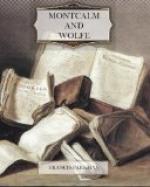Amherst brought up his artillery and began approaches in form, when, on the night of the twenty-third, it was found that Bourlamaque had retired down Lake Champlain, leaving four hundred men under Hebecourt to defend the place as long as possible. This was in obedience to an order from Vaudreuil, requiring him on the approach of the English to abandon both Ticonderoga and Crown Point, retreat to the outlet of Lake Champlain, take post at Isle-aux-Noix, and there defend himself to the last extremity;[726] a course unquestionably the best that could have been taken, since obstinacy in holding Ticonderoga might have involved the surrender of Bourlamaque’s whole force, while Isle-aux-Noix offered rare advantages for defence.
[Footnote 726: Vaudreuil au Ministre, 8 Nov. 1759. Instructions pour M. de Bourlamaque, 20 Mai, 1759, signe Vaudreuil. Montcalm a Bourlamaque, 4 Juin, 1759.]
The fort fired briskly; a cannon-shot killed Colonel Townshend, and a few soldiers were killed and wounded by grape and bursting shells; when, at dusk on the evening of the twenty-sixth, an unusual movement was seen among the garrison, and, about ten o’clock, three deserters came in great excitement to the English camp. They reported that Hebecourt and his soldiers were escaping in their boats, and that a match was burning in the magazine to blow Ticonderoga to atoms. Amherst offered a hundred guineas to any one of them who would point out the match, that it might be cut; but they shrank from the perilous venture. All was silent till eleven o’clock, when a broad, fierce glare burst on the night, and a roaring explosion shook the promontory; then came a few breathless moments, and then the fragments of Fort Ticonderoga fell with clatter and splash on the water and the land. It was but one bastion, however, that had been thus hurled skyward. The rest of the fort was little hurt, though the barracks and other combustible parts were set on fire, and by the light the French flag was seen still waving on the rampart.[727] A sergeant of the light infantry, braving the risk of other explosions, went and brought it off. Thus did this redoubted stronghold of France fall at last into English hands, as in all likelihood it would have done a year sooner, if Amherst had commanded in Abercromby’s place; for, with the deliberation that marked all his proceedings, he would have sat down before Montcalm’s wooden wall and knocked it to splinters with his cannon.




